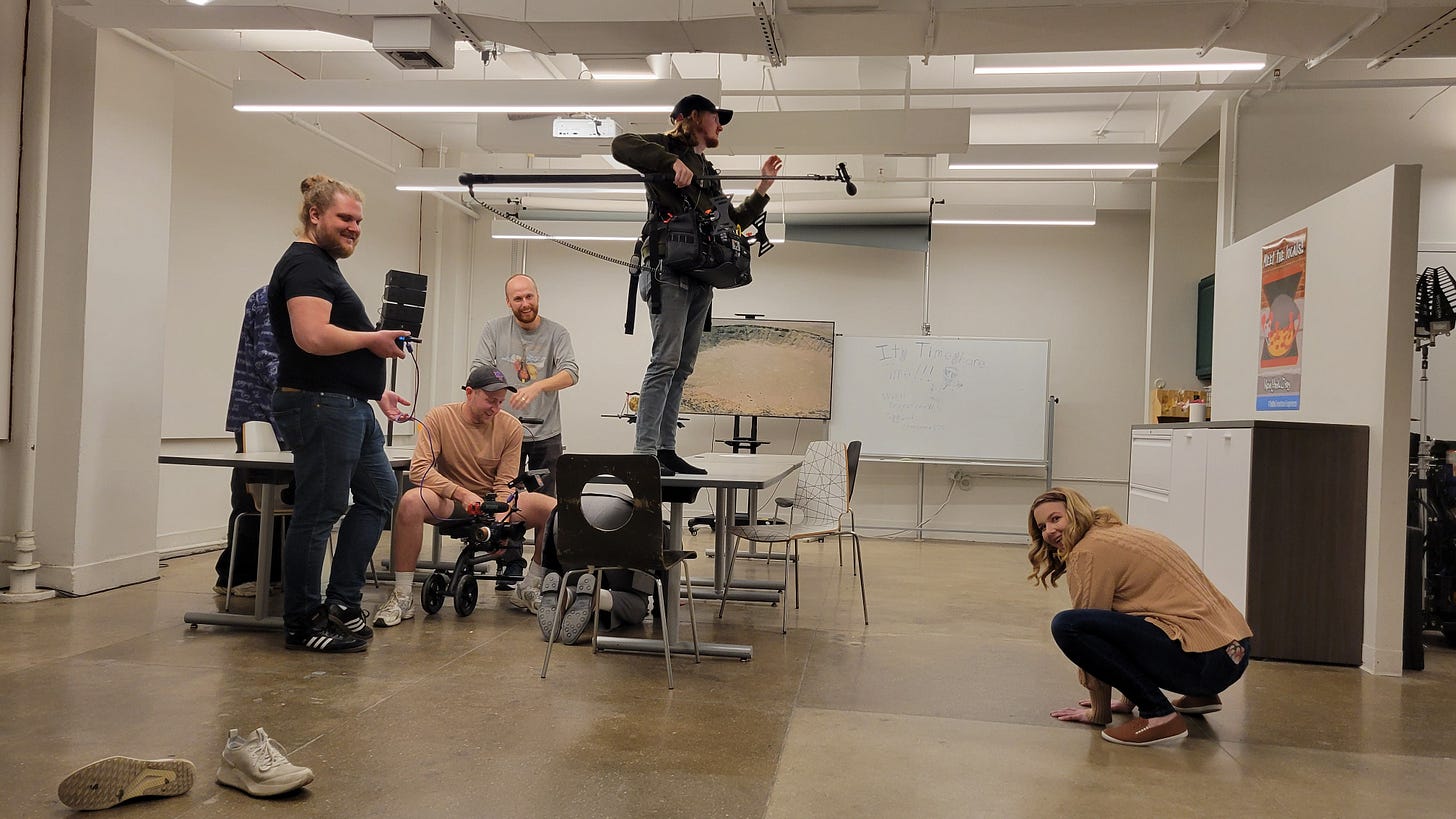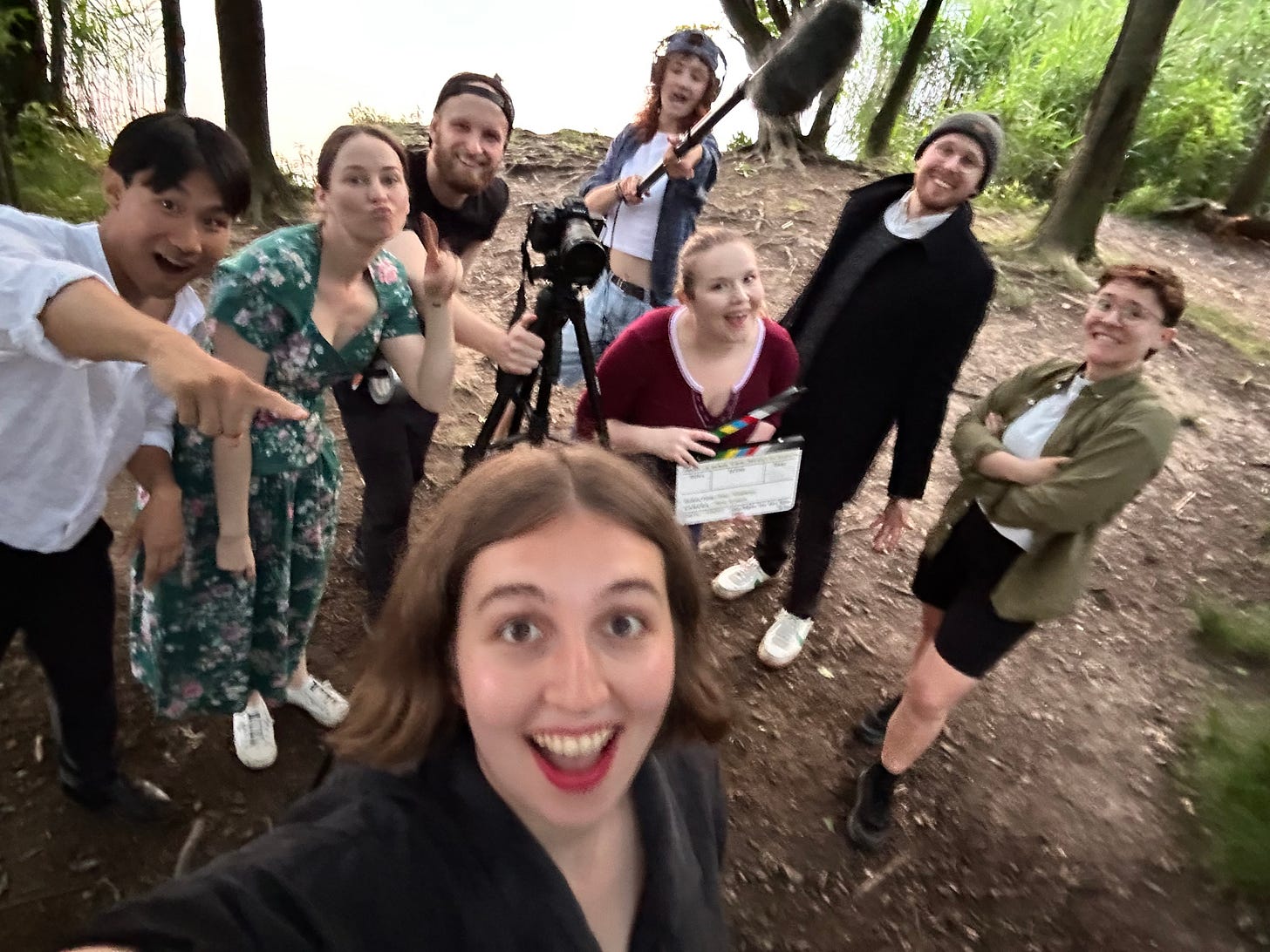If you’ve spent time on low-to-no-budget film sets, you’ve probably noticed that while some sets are boring, frustrating, and just feel like a job, some are efficient, pleasant, and a whole lot of fun.
While you might leave that first kind of set exhausted and vowing never to work with certain members of the cast or crew again, you usually leave that second kind of set energized and with everyone eager to keep working together — and the good energy on set almost always makes itself felt in the final film.

So what is it that makes those “good sets” so good?
I’ve noticed in my years on set that there are actually a few simple, practical things you can do to turn just about any set into one of these mythical “good sets.”
It’s worth noting that you definitely don’t need to do everything on this list to make a set good, but any of these things, if done right, should make the set just a little bit more efficient and fun.
1. Good food
The importance of food is very easy to underestimate (and I’m definitely guilty of this), but it’s one of the simplest and most impactful changes you can make to the mood on set.
This means a) making sure to have an ample amount of healthy, energizing snacks available on set (think trail mix, fruit, yogurt, carrots and hummus), and b) ordering lunch or dinner from a nice place and letting everyone pick what dish they want.
It can also be fun, especially for a shoot you know will be long, cold, hot, overnight, or in any way arduous, to get some secret “fun snacks” as well, i.e. chocolate or dessert, and quietly put them out with the rest of the food at a time when you feel the mood on set flagging, or to celebrate at the end of the shoot.
Good on-set food has the power to keep everyone’s energy up over a long or difficult shoot, give people a little boost when dessert appears or that food they were looking forward to arrives, and make everyone feel like they’re being treated well, regardless of whether they’re being paid.
2. Not paying people / working for free
On that note, this may sound counterintuitive and definitely won’t work for every low-budget film, I’ve noticed that people generally have a lot more fun on set if they’re working for free rather than working for embarrassingly low pay.
It actually makes a lot of psychological sense: if I’m on set eating sad pizza and making ~ $5/hour, I feel like I’m just clocking in and out for an underpaid job, whereas if I’m eating that tasty Pad Thai I ordered and working for free, I feel like I’m here to hang out, have a good time, and help some people I like make a movie.
The flip-side of that is that if you are or would like to be a director, you should absolutely be working on your friends’ shoots for free. This is an awesome way to get to know cast and crew and if you’re lucky, you’ll end up in a delightful reciprocal little community where you all “pay” each other by taking turns helping each other out.
3. Thanking people (repeatedly, effusively)
This is particularly important if everyone’s working for free, but it’s true on just about any low-budget set: you want to remember at all times that these people are not your employees, they’re a group of talented people who took the time out of their everyday lives to do you a favor and help you make your movie, and should be treated as such.
There’s really no bad time to thank people on set — you can thank them when they agree to be in the film, when you’re making announcements via email or text, before you start shooting, during the shoot, after the shoot, or all of the above.
You want your cast and crew to know that you really appreciate what they’re doing, and that you want to make sure that they have a great time.
4. Telling people when you like what they’re doing
It’s a cardinal rule of filmmaking that everyone on set is a lot more insecure than you think they are, and it’s crucial to take a second and tell people when they’re doing a great job, particularly between takes and at the end of the shoot.
5. Telling people when you don’t like what they’re doing
Across the board, actors and crew always prefer getting notes to just mysteriously being told to “do another take.”
Actors will often assume that they were doing something in the take you didn’t like, and will be very grateful to hear either what that was (i.e. “That was great, but I think this time you should take his argument a little more seriously instead of just brushing him off right away”) or that the re-take has nothing to do with them (i.e. “That was perfect, we just need to do another take with no sirens in the background”).
6. Directing (everyone) from the inside out
This one can vary based on your directorial style, but I really like giving actors internal rather than external notes, i.e. “This is what’s going through your head when he says that” rather than “Do it again, but louder.”
I find that this is a nice way to get actors to give the performance you want but in their own way, and it’s something which I’d like to start doing more for crew as well — i.e. “The shot should feel like it’s almost closing in on them” instead of “Tilt up! No, wait. Down.”
7. Knowing what your film is about
This is really at the heart of any good film set, and is what will make every decision easy, and make your cast and crew feel like you’re all moving together towards a clear goal.
Basically, before you get on set you want to take the time to really think about your film, both how it should feel and what you’re trying to convey.
To quote Eric Sherman’s introduction to the excellent Directing the Film (1976):
The emotional power of a film is determined not so much by any one element, line of dialogue, shot, cut, or acting performance. Rather, we look for the film as a whole to possess an overall unity of expression, intensity of performance, and beauty and completeness of vision. …[T]he director’s concern is always conditioned by a sense of the whole. He selects and guides all the other work and shapes it along the necessary route to achieve that finality he has in mind.
It’s the ability to make these calls — about lights, framing, costuming, whether to do another take — as a result of your understanding of the film as a whole that gives everyone on set confidence that you know what you’re doing, and gives your film the coherence it deserves.
8. Lies and deception
As anyone who has worked with me can tell you, this is one of my absolute favorite things to do on set. Essentially, you want to limit knowledge of any and all problems to the people who can help solve them.
This means that, for example, if the shoot is running late, the only people who should know this are the people who can help make up the time, i.e. the director and the cinematographer, since they have the power to remove or simplify upcoming shots. If the actors hear that we’re running late, it’s more likely to hurt their performance than to help it, and either way will add stress for them that they don’t need.
To that end, whenever I’m directing or assistant directing, I like to make a separate crew-only schedule alongside the call sheet, which indicates precisely how long we expect prep and shooting for each scene to take — this way, we’re the only people who know if we’ve deviated from that schedule, and as long as we make the wrap time on the call sheet, we can make up the time however we like without the cast ever knowing that anything went wrong.
I had a really great moment a few weeks ago when I was leaving a shoot I’d assistant-directed with some of the cast, and one of the actresses mentioned that it was nice that nothing had really gone wrong at all during the shoot day.
This was one of my proudest moments as an AD because in fact, a comical series of events had meant that we were missing the main character’s shirt for the first two hours of the shoot, and had had to scramble to rearrange the order of the shots within the scene and send a PA on a desperate mission to get it, but the whole time the actors had been able to go happily on with no idea that anything had happened, devoting all their attention to having a good time and giving a good performance.
9. A wrap party
This can be as simple as taking everyone out for food or drinks right after the shoot wraps, or as complex as hosting a separate wrap party and/or screening party for the cast and crew, but it’s a really nice way to cement the relationships between everyone on set, and to have everyone leave your production with the feeling that it was a good time.
And if you’re able to do even just a few of these things on set, it almost certainly will have been.
The film dispatch
I had a great release last month for Ghost Light, that madcap solo filmmaking adventure I wrote about in my last post, and at the end of this month I’ll be releasing another new film, a slightly surreal little love story I shot with a great crew back in February and that I’m quite excited for people to see.
I’ve been on set a whole lot since we last spoke — I assistant-directed two films earlier this month and directed a new short last night (!!), which is about what happens when things on set go… not so well, and will be coming out at the end of July.

If you’d like to hear more in-depth thoughts about both of those films — and to see them a week early — feel free to subscribe to The Film Club, a private, slightly more personal newsletter where I send out my new films early, accompanied by longer-form commentary about how each one came to be.
Thoughts?
If you have any thoughts about what makes a film set feel good or bad, or any other tips and tricks for making sure everyone has a good time, I’d love to hear from you!






